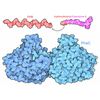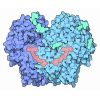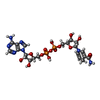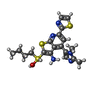[English] 日本語
 Yorodumi
Yorodumi- PDB-8cvn: Cryo-EM Structure of Human 15-PGDH in Complex with Small Molecule... -
+ Open data
Open data
- Basic information
Basic information
| Entry | Database: PDB / ID: 8cvn | ||||||
|---|---|---|---|---|---|---|---|
| Title | Cryo-EM Structure of Human 15-PGDH in Complex with Small Molecule SW209415 | ||||||
 Components Components | 15-hydroxyprostaglandin dehydrogenase [NAD(+)] | ||||||
 Keywords Keywords |  OXIDOREDUCTASE / OXIDOREDUCTASE /  DEHYDROGENASE / DEHYDROGENASE /  INHIBITOR / OXIDOREDUCTASE-INHIBITOR complex INHIBITOR / OXIDOREDUCTASE-INHIBITOR complex | ||||||
| Function / homology |  Function and homology information Function and homology information 15-hydroxyprostaglandin dehydrogenase (NAD+) / 15-hydroxyprostaglandin dehydrogenase (NAD+) /  15-hydroxyicosatetraenoate dehydrogenase / regulation of prostaglandin catabolic process / ductus arteriosus closure / 15-hydroxyicosatetraenoate dehydrogenase / regulation of prostaglandin catabolic process / ductus arteriosus closure /  ovulation / thrombin-activated receptor signaling pathway / ovulation / thrombin-activated receptor signaling pathway /  prostaglandin E receptor activity / prostaglandin E receptor activity /  15-hydroxyprostaglandin dehydrogenase (NAD+) activity / Synthesis of Lipoxins (LX) / 15-hydroxyprostaglandin dehydrogenase (NAD+) activity / Synthesis of Lipoxins (LX) /  parturition ... parturition ... 15-hydroxyprostaglandin dehydrogenase (NAD+) / 15-hydroxyprostaglandin dehydrogenase (NAD+) /  15-hydroxyicosatetraenoate dehydrogenase / regulation of prostaglandin catabolic process / ductus arteriosus closure / 15-hydroxyicosatetraenoate dehydrogenase / regulation of prostaglandin catabolic process / ductus arteriosus closure /  ovulation / thrombin-activated receptor signaling pathway / ovulation / thrombin-activated receptor signaling pathway /  prostaglandin E receptor activity / prostaglandin E receptor activity /  15-hydroxyprostaglandin dehydrogenase (NAD+) activity / Synthesis of Lipoxins (LX) / 15-hydroxyprostaglandin dehydrogenase (NAD+) activity / Synthesis of Lipoxins (LX) /  parturition / lipoxygenase pathway / Biosynthesis of D-series resolvins / Biosynthesis of E-series 18(S)-resolvins / Synthesis of Prostaglandins (PG) and Thromboxanes (TX) / parturition / lipoxygenase pathway / Biosynthesis of D-series resolvins / Biosynthesis of E-series 18(S)-resolvins / Synthesis of Prostaglandins (PG) and Thromboxanes (TX) /  Oxidoreductases; Acting on the CH-OH group of donors; With NAD+ or NADP+ as acceptor / oxidoreductase activity, acting on the CH-OH group of donors, NAD or NADP as acceptor / prostaglandin metabolic process / negative regulation of cell cycle / Oxidoreductases; Acting on the CH-OH group of donors; With NAD+ or NADP+ as acceptor / oxidoreductase activity, acting on the CH-OH group of donors, NAD or NADP as acceptor / prostaglandin metabolic process / negative regulation of cell cycle /  NAD+ binding / positive regulation of vascular associated smooth muscle cell proliferation / transforming growth factor beta receptor signaling pathway / NAD+ binding / positive regulation of vascular associated smooth muscle cell proliferation / transforming growth factor beta receptor signaling pathway /  kidney development / female pregnancy / NAD binding / response to estradiol / basolateral plasma membrane / response to ethanol / response to lipopolysaccharide / positive regulation of apoptotic process / extracellular exosome / kidney development / female pregnancy / NAD binding / response to estradiol / basolateral plasma membrane / response to ethanol / response to lipopolysaccharide / positive regulation of apoptotic process / extracellular exosome /  nucleoplasm / identical protein binding / nucleoplasm / identical protein binding /  cytosol / cytosol /  cytoplasm cytoplasmSimilarity search - Function | ||||||
| Biological species |   Homo sapiens (human) Homo sapiens (human) | ||||||
| Method |  ELECTRON MICROSCOPY / ELECTRON MICROSCOPY /  single particle reconstruction / single particle reconstruction /  cryo EM / Resolution: 2.4 Å cryo EM / Resolution: 2.4 Å | ||||||
 Authors Authors | Huang, W. / Taylor, D.J. | ||||||
| Funding support |  United States, 1items United States, 1items
| ||||||
 Citation Citation |  Journal: Nat Commun / Year: 2023 Journal: Nat Commun / Year: 2023Title: Small molecule inhibitors of 15-PGDH exploit a physiologic induced-fit closing system. Authors: Wei Huang / Hongyun Li / Janna Kiselar / Stephen P Fink / Sagar Regmi / Alexander Day / Yiyuan Yuan / Mark Chance / Joseph M Ready / Sanford D Markowitz / Derek J Taylor /  Abstract: 15-prostaglandin dehydrogenase (15-PGDH) is a negative regulator of tissue stem cells that acts via enzymatic activity of oxidizing and degrading PGE2, and related eicosanoids, that support stem ...15-prostaglandin dehydrogenase (15-PGDH) is a negative regulator of tissue stem cells that acts via enzymatic activity of oxidizing and degrading PGE2, and related eicosanoids, that support stem cells during tissue repair. Indeed, inhibiting 15-PGDH markedly accelerates tissue repair in multiple organs. Here we have used cryo-electron microscopy to solve the solution structure of native 15-PGDH and of 15-PGDH individually complexed with two distinct chemical inhibitors. These structures identify key 15-PGDH residues that mediate binding to both classes of inhibitors. Moreover, we identify a dynamic 15-PGDH lid domain that closes around the inhibitors, and that is likely fundamental to the physiologic 15-PGDH enzymatic mechanism. We furthermore identify two key residues, F185 and Y217, that act as hinges to regulate lid closing, and which both inhibitors exploit to capture the lid in the closed conformation, thus explaining their sub-nanomolar binding affinities. These findings provide the basis for further development of 15-PGDH targeted drugs as therapeutics for regenerative medicine. | ||||||
| History |
|
- Structure visualization
Structure visualization
| Structure viewer | Molecule:  Molmil Molmil Jmol/JSmol Jmol/JSmol |
|---|
- Downloads & links
Downloads & links
- Download
Download
| PDBx/mmCIF format |  8cvn.cif.gz 8cvn.cif.gz | 94.5 KB | Display |  PDBx/mmCIF format PDBx/mmCIF format |
|---|---|---|---|---|
| PDB format |  pdb8cvn.ent.gz pdb8cvn.ent.gz | 75.7 KB | Display |  PDB format PDB format |
| PDBx/mmJSON format |  8cvn.json.gz 8cvn.json.gz | Tree view |  PDBx/mmJSON format PDBx/mmJSON format | |
| Others |  Other downloads Other downloads |
-Validation report
| Arichive directory |  https://data.pdbj.org/pub/pdb/validation_reports/cv/8cvn https://data.pdbj.org/pub/pdb/validation_reports/cv/8cvn ftp://data.pdbj.org/pub/pdb/validation_reports/cv/8cvn ftp://data.pdbj.org/pub/pdb/validation_reports/cv/8cvn | HTTPS FTP |
|---|
-Related structure data
| Related structure data |  27010MC  8cwlC  8fd8C M: map data used to model this data C: citing same article ( |
|---|---|
| Similar structure data | Similarity search - Function & homology  F&H Search F&H Search |
- Links
Links
- Assembly
Assembly
| Deposited unit | 
|
|---|---|
| 1 |
|
- Components
Components
| #1: Protein | Mass: 27886.053 Da / Num. of mol.: 2 Source method: isolated from a genetically manipulated source Source: (gene. exp.)   Homo sapiens (human) / Gene: HPGD, PGDH1, SDR36C1 Homo sapiens (human) / Gene: HPGD, PGDH1, SDR36C1Production host: References: UniProt: P15428,  15-hydroxyprostaglandin dehydrogenase (NAD+), 15-hydroxyprostaglandin dehydrogenase (NAD+),  Oxidoreductases; Acting on the CH-OH group of donors; With NAD+ or NADP+ as acceptor, Oxidoreductases; Acting on the CH-OH group of donors; With NAD+ or NADP+ as acceptor,  15-hydroxyicosatetraenoate dehydrogenase 15-hydroxyicosatetraenoate dehydrogenase#2: Chemical |  Nicotinamide adenine dinucleotide Nicotinamide adenine dinucleotide#3: Chemical | Has ligand of interest | Y | |
|---|
-Experimental details
-Experiment
| Experiment | Method:  ELECTRON MICROSCOPY ELECTRON MICROSCOPY |
|---|---|
| EM experiment | Aggregation state: PARTICLE / 3D reconstruction method:  single particle reconstruction single particle reconstruction |
- Sample preparation
Sample preparation
| Component | Name: HUMAN 15-PGDH IN COMPLEX WITH INHIBITOR / Type: COMPLEX / Entity ID: #1 / Source: RECOMBINANT |
|---|---|
| Source (natural) | Organism:   Homo sapiens (human) Homo sapiens (human) |
| Source (recombinant) | Organism:   Escherichia coli (E. coli) Escherichia coli (E. coli) |
| Buffer solution | pH: 7.4 |
| Specimen | Embedding applied: NO / Shadowing applied: NO / Staining applied : NO / Vitrification applied : NO / Vitrification applied : YES : YES |
Vitrification | Cryogen name: ETHANE |
- Electron microscopy imaging
Electron microscopy imaging
| Experimental equipment |  Model: Titan Krios / Image courtesy: FEI Company |
|---|---|
| Microscopy | Model: FEI TITAN KRIOS |
| Electron gun | Electron source : :  FIELD EMISSION GUN / Accelerating voltage: 300 kV / Illumination mode: FLOOD BEAM FIELD EMISSION GUN / Accelerating voltage: 300 kV / Illumination mode: FLOOD BEAM |
| Electron lens | Mode: BRIGHT FIELD Bright-field microscopy / Nominal defocus max: 2000 nm / Nominal defocus min: 250 nm Bright-field microscopy / Nominal defocus max: 2000 nm / Nominal defocus min: 250 nm |
| Image recording | Electron dose: 1.08 e/Å2 / Film or detector model: GATAN K3 BIOQUANTUM (6k x 4k) |
- Processing
Processing
| Image processing |
| |||||||||||||||||||||
|---|---|---|---|---|---|---|---|---|---|---|---|---|---|---|---|---|---|---|---|---|---|---|
CTF correction |
| |||||||||||||||||||||
3D reconstruction |
| |||||||||||||||||||||
| Refinement | Highest resolution: 2.4 Å |
 Movie
Movie Controller
Controller




 PDBj
PDBj










